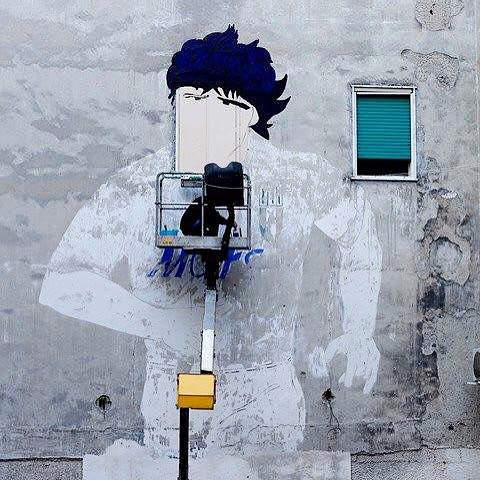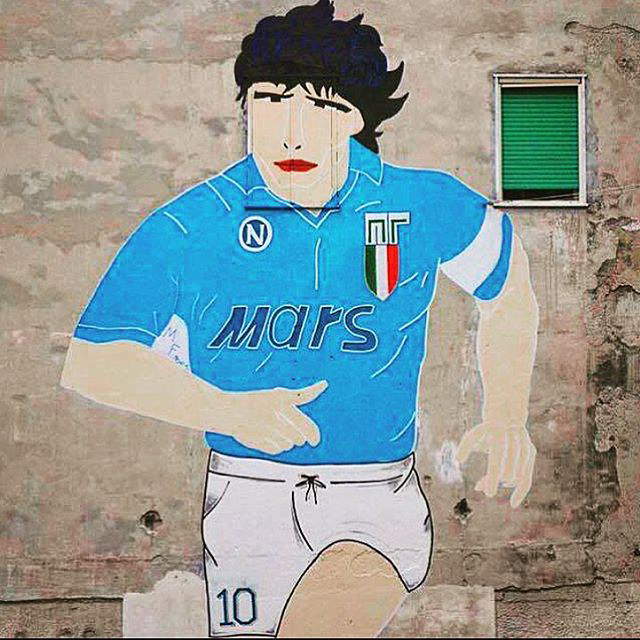It can now be said to be part of Italy’s historical murals: it is the one that was made in 1990 in the Quartieri Spagnoli in Naples and that depicts Diego Armando Maradona (Lanús, 1960 - Tigre, 2020), wearing the number 10 jersey of Napoli (the historic jersey of the 1980s, with the Mars sponsor), on his chest the Scudetto he has just won (the one from the 1989-1990 championship, the second and so far last in the history of the Neapolitan team: the first is from the 1986-1987 championship, two years after Maradona’s arrival) and on his arm the captain’s armband. Naples has always had a very close relationship with the Argentine champion, who arrived from Barcelona in 1984 and remained on the shores of the Gulf in 1991 before moving to Sevilla.
The mural was made precisely to celebrate Napoli’s second Scudetto, for which Maradona’s contribution was decisive: for him 16 goals in 28 games, the highest number of goals the “Pibe de Oro” has scored in a league outside Argentina, and also his best scoring average with a European team. Author of the work was an artist only twenty-three years old, Mario Filardi, who later passed away in 2010 in Zurich under circumstances still to be clarified. And Filardi’s is itself a story within a story: an artist by passion, he did a completely different job in life, since all his life he traveled the world as a waiter. Switzerland, London, Madrid, Australia, Frankfurt. He came from a family in financial difficulty and from a very young age he wanted to avoid burdening his family: nevertheless, when he returned to Naples, he loved to arm himself with paints to paint. And he did so again in the late spring of 1990, when Naples was celebrating the victory of its second Scudetto.
To draw the picture, Filardi had relied on a small photograph of Maradona. “He was a huge Diego fan,” his sister Teresa told Il Napolista magazine in a 2016 interview. “That mural was created to honor Maradona because he had won us two Scudettos. When we won the second scudetto, all the Napoli fan boys, led by Bostik, came to call Mario because he was good and asked him to do the drawing. He worked for two nights and three days, they helped him by keeping the car headlights on to illuminate the wall while he drew. He stood on that precarious scaffolding, and I stood underneath watching, not even being able to go to sleep, because I was afraid he would fall and everything would fall on him.” And it was a collective work, because the whole ward participated in its realization. Teresa Filardi recounts that there were people who kept her brother Mario company while he was painting, others who passed him the materials and the Innocenti pipes, she on the other hand ... prepared his snack. It was a huge job done extremely quickly for a passionate artist who did something else for a living: “If you see the picture he has a tired face, he killed himself to do the mural,” his sister recalled.
 |
| Mario Filardi’s mural in a vintage photo. |
Maradona, in Mario Filardi’s mural, was portrayed running, stylized, almost as if he were a comic book hero: because after all, this is Maradona for Naples. A sort of superhero. A deity of the city’s popular pantheon. When the work was finished, the sky of Naples was lit up by some fireworks that, as is traditional in Naples, are used to celebrate an event. And that mural, it can be said, has become part of the city’s history: even today, many tourists still go specifically to the Quartieri Spagnoli, via De Deo, to admire it. And they are not only soccer fans or enthusiasts, since Maradona’s image is now an icon of Neapolitan-ness, for many it is almost impossible to separate the city from the greatest soccer player ever seen in these parts (and for many he is even the greatest player in history).
In the meantime, however, the work had begun to deteriorate, and then, in the late 1990s, an abusive window was opened on the wall, erasing the Pibe’s face. Mario’s dream was to repaint the work, above the window shutter, so that the aesthetic balance of the mural would remain as intact as possible. It was a dream destined to remain so, because the work did not allow him the time to complete it and, as anticipated, the artist passed away in 2010, and because the restoration had costs that Mario could not bear alone. Abandoned to the most blighted degradation, the work, by 2016, had almost completely faded, so efforts were made to restore it. Also in agreement with the new owner of the apartment of the infamous window: another Maradona fan who agreed to have the shutter painted so as to reconstruct the champion’s face.
The initiative to restore the painting came from an artist, Salvatore Iodice, also a boy from the Quartieri Spagnoli (his carpenter’s store is located right in the neighborhood), who proposed to the Filardi family to repaint the mural, which by then had almost completely vanished: Iodice raised the necessary sum for the intervention (three thousand euros), also got help from the municipality (which provided a forklift), obtained all the necessary permits, and kept the compositional structure of Mario Filardi’s mural, but decided to reinterpret the figure of the Argentine striker. Iodice had tried to be as respectful as possible to Filardi’s original, repurposing the Maradona in a cartoonish key from the original work. For Iodice, it was a kind of homage, although the inhabitants of the Spanish Quarter would have preferred what is called an “artistic restoration,” to give the footballer a more realistic face.As a result, a new intervention was arrived at in 2017, that of the well-known Argentine street artist Francisco Bosoletti, already the author of several important works of urban art in some of the most problematic areas of the Campania capital.
Bosoletti was on Via De Deo to execute a mural in homage to Antonio Corradini’s Pudicizia, the Venetian artist’s statue that adorns the Sansevero Chapel. He initially had some hesitation to intervene on a colleague’s mural, but then Salvatore Iodice agreed, in deference to the wishes of the inhabitants of the neighborhood, and so, in the fall of 2017, the Argentine artist gave Maradona a more natural-looking face, while leaving the rest of his body untouched. Thus, wrote Marco Perillo in Mattino di Napoli at the end of Bosoletti’s intervention, “’his’ Maradona’s head stands as of today on that building, closing the circle of an all-Argentine-Napoletan story of passion.”
 |
| Salvatore Iodice at work during the restoration of Mario Filardi’s mural. Ph. Credit @gioimprota |
 |
| Maradona’s mural restored by Salvatore Iodice. Ph. Credit @franclucas86 |
 |
| Maradona’s mural after Bosoletti’s intervention. Ph. Credit Academy of Fine Arts Santa Giulia |
Today the Spanish Quarter’s Maradona mural is a sort of attraction, an icon, even appearing in several tourist guides of the city. Recognition to its creator came posthumously: in 2016, the City of Naples put up a plaque on Via De Deo to remember the artist who paid tribute to Maradona with a work that has become world famous. Mario Filardi had also taken to making other works, always on the walls of his city, and always when work breaks allowed him to do so. Unfortunately, he never managed to pursue an “official” or emblazoned career, but it matters little. In the history of Italian street art there is a place for him as well.
Warning: the translation into English of the original Italian article was created using automatic tools. We undertake to review all articles, but we do not guarantee the total absence of inaccuracies in the translation due to the program. You can find the original by clicking on the ITA button. If you find any mistake,please contact us.